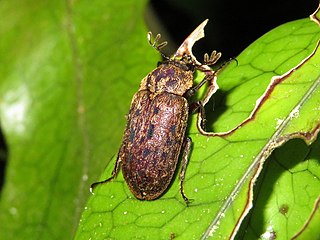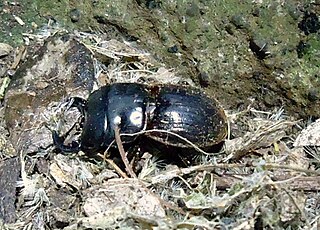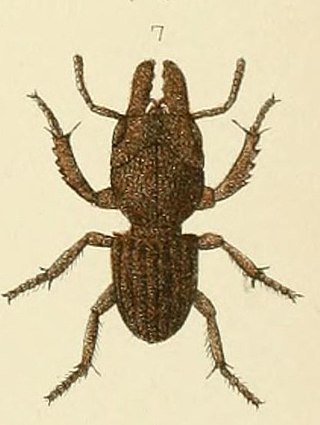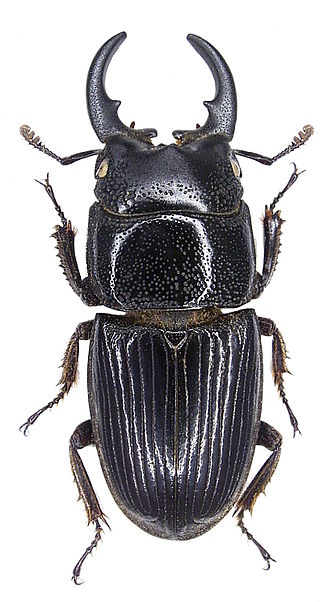
Stag beetles are a family of about 1,200 species of beetles in the family Lucanidae, currently classified in four subfamilies. Some species grow to over 12 centimetres, but most to about 5 cm (2 in).

The false stag beetles (Diphyllostoma) are a group of three species of rare beetles known only from California. Almost nothing is known of their life history beyond that the adults are diurnal and females are flightless; larvae have not been observed.

The Lucaninae comprise the largest subfamily of the stag beetles (Lucanidae).

Lucanus cervus, known as the European stag beetle, or the greater stag beetle, is one of the best-known species of stag beetle in Western Europe, and is the eponymous example of the genus. L. cervus is listed as Near Threatened by the IUCN Red List.

Cyclommatus is a genus of the family Lucanidae, also known as the stag beetle. The majority of the species from the genus Cyclommatus are located in Southeast Asia, though some species are found in China and Taiwan as well. The genus Cyclommatus also consists of three subgenera: Cyclommatus, Cyclommatinus and Cyclommatellus. Each subgenera contains 80, 24 and 3 species respectively. In total, the genus Cyclommatus consists of a total of 134 species, though more are still being discovered to this day.

Mitophyllus is a genus of large stag beetles endemic to New Zealand.

Mitophyllus parrianus, is a species of stag beetle native to New Zealand. M. parrianus is found throughout the North, South and Stewart Islands of New Zealand.

Geodorcus helmsi, known as New Zealand giant stag beetle or Helms's stag beetle, is a large, slow-moving, flightless stag beetle in the family Lucanidae. It is endemic to New Zealand.

Geodorcus capito is a large flightless species of stag beetle in the family Lucanidae. It is endemic to the Chatham Islands in New Zealand.

Geodorcus alsobius, or Moehau stag beetle, is a large flightless species of stag beetle in the family Lucanidae. It is found only on Mt Moehau, the highest mountain in the Moehau Range on the Coromandel Peninsula in New Zealand.

Geodorcus auriculatus is a large flightless stag beetle that is found in the southern part of the Coromandel Peninsula and on Mount Te Aroha in the Kaimai range of New Zealand.

Geodorcus ithaginis, the Mokohinau stag beetle, is a large flightless species of stag beetle in the family Lucanidae. It was described by Thomas Broun in 1893 after being discovered in the Mokohinau Islands by Andreas Stewart Sandager, a lighthouse keeper on the islands. The species survives only on the small unnamed island "Stack H", in a patch of vegetation the size of a living room, and is in extreme danger of extinction.
Geodorcus montivagus is a large flightless species of stag beetle in the family Lucanidae. It is known from only one female specimen found on the Victoria Range in New Zealand. It was found in tussock at 1,220 metres (4,000 ft) above sea level.

Geodorcus novaezealandiae is a large flightless species of stag beetle in the family Lucanidae. It is the type species and smallest member of the genus Geodorcus. It is endemic to New Zealand.

Geodorcus philpotti is a large flightless species of stag beetle in the family Lucanidae. It was named by Major Thomas Broun after Mr A. Philpott, who discovered it at Hump Ridge near Invercargill. It is endemic to New Zealand.

Geodorcus servandus is a large flightless species of stag beetle in the family Lucanidae. It was discovered by P.R. Kettle in December 1960 and this holotype specimen is held in the New Zealand Arthropod Collection. It was first described by Beverley Holloway in 2007. Its type location is Mount Tuhua summit, near Lake Kaniere on the West Coast of New Zealand. The name servandus is a Latin word meaning "[something] to be preserved, conserved, looked after".

Geodorcus sororum is a large flightless species of stag beetle in the family Lucanidae. It was discovered in 1973 by Mr. A. Wright on an expedition to Middle Sister Island/Te Awanui, one of The Sisters Islands/Rangitatahi which are part of the Chatham Islands in New Zealand. This holotype specimen is held in the New Zealand Arthropod Collection. It was first described by Beverley Holloway in 2007. The name sororum is translated from Latin to mean "belonging to the sisters".

Paralissotes is a genus of stag beetle that is endemic to New Zealand.

Aegus chelifer, is a species of stag beetle found in Indo-Malaya regional countries.

Dorcus hopei is a beetle in the family Lucanidae.




















